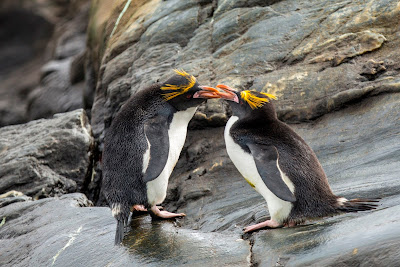Here are some of my images from the latest voyages. Better ones (taken by other passengers with fancier cameras and kindly shared) can be found in the blog below "Antarctica Nov 2016 - Jan 2017.
Chinstrap on remote camera, Orne Harbour
 Chinstraps on their highway up to the ridge above Orne Harbour. (click on image to enlarge)
The kitchen at Port Lockroy, just as it was in the 1950s when it was a British research station, studying ionospherics. It is now a historic monument, complete with post office, gift shop and Gentoo Penguin colony.
Chinstraps on their highway up to the ridge above Orne Harbour. (click on image to enlarge)
The kitchen at Port Lockroy, just as it was in the 1950s when it was a British research station, studying ionospherics. It is now a historic monument, complete with post office, gift shop and Gentoo Penguin colony.
Two Gentoos hurry downhill from their nests to the sea for more krill.
A Leopard Seal rests on an ice-floe as we start a zodiac cruise. Passengers are lining up ready to go down the gangway into the boats.
Zodiac cruises are just as much about admiring the ice as looking for wildlife. We had many calm, sunny days during November and December 2016.
A fiery sunset adds a splash of gold to the usual Antarctic colour spectrum of white, blue and black (where rock is exposed).
Adelies rest on a sunny floe with a huge ice-cliff behind.
Lonely Adelie!
We ended our last full day with a two spectacular days in West Falklands. Rockhopper Penguins and Black-browed Albatross nest together in tight mixed colonies. There are frequent squabbles between the masters of the air and their distant relatives which can't even fly!
Our penguin scientists Melissa and Steve: Melissa is showing off her ring, soon after Steve's proposal among the seabird colonies of New Island!
Portrait of a Black-browed Albatross, Westpoint Island.
On January 6, most of the albatross chicks were about a month old. They will make their first flight at the beginning of April.
All too often I post other people's photos! Here are some of mine from my latest Antarctica season with One Ocean Expeditions. Young bull Elephant Seal, South Georgia.

Snow Petrel on nest, Brown Bluff. 'Digiscoped' through the ship's scope, hence the vignetting in the corners. I only carry a Nikon Coolpix that fits in my pocket!
Our kayakers paddling past a small part of the huge Adelie colony at Brown Bluff. (Click to enlarge the image).
Adelie in zodiac. Occasionally they mistake our boats for black rocks. My colleague calmly reacts by taking out his camera. It soon jumped off again.

On one of our visits to Elephant Island, conditions were so calm that we were able to take a zodiac cruise at Point Wild, where Shackleton's crew were marooned for four months awaiting rescue. This is the monument erected by the Chileans to Pilotto Pardo, the tug captain who effected the rescue in August 1916. The Chinstraps that nourished Shackleton's men (or rather their descendants) are still there!
Vavilov dining room! Home of three fine meals every day!
My homework! I can never stop finding amazing things out about penguins!
Turret Point, with the Vavilov at anchor. This is the majority of the failing Adelie colony. It used to number thousands, but is now down to a few pairs. Taking Antarctica as a whole, Adelie numbers are stable, but here in the South Shetlands they are on the edge of their range. Successful Adelie colonies are always close to sea-ice (under which the krill feeds on the phytoplankton). Decreasing sea-ice here as the climate warms makes longer and longer foraging journeys for the Adelies.
Close-up of the same colony, with half-grown soot-coloured chicks.
Two friends and staff colleagues: Tammie and Hilary.
Warm enough to sit outside? The stern deck BBQ makes a chilly change from the dining room.
Chinstraps in the sun: Orne Harbour.
Idyllic Antarctic scene - descending from the mountaineering Chinstraps at Orne Harbour.
Part 2 will be posted soon!
Here's a brief overview of my 7 weeks working as staff ornithologist on the Akademik Sergei Vavilov. There she is in the background, eclipsed by a frolicsome young Humpback Whale that breached 20 times or so as we were close by in zodiacs. (Not too close!) There were several Humpbacks in Wilhelmina Bay that day in December. We visited there in November, before any had arrived from the tropical waters where they breed. But as the summer progresses, numbers build up spectacularly. They have recovered better than any other whale from the depredations of the whaling years.

This image was on the same zodiac cruise, but we can't be sure if this was the same whale. This looking-around behaviour is known as spy-hopping: the small eye is visible to the right of the huge mouth. On the throat and stretching down to the belly are the ventral pleats which expand into a vast balloon, filled with water and krill. By bringing the tongue up to the palate, the water is extruded through the baleen plates, leaving a ball of krill to swallow. In the background is one of our zodiacs and a few Kelp Gulls, on the lookout for spilt krill.
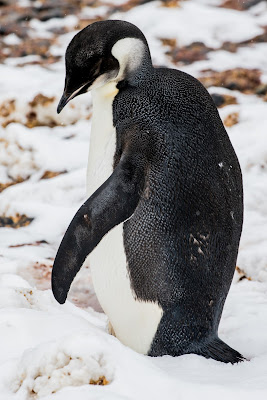
I was on board for four voyages: during the first we had two Emperor Penguin encounters - both far north of their usual range. This immature came first, on Half Moon Island. I had the privilege of finding it for myself, as I laid out a trail for passengers to follow. It stood with my back to me, asleep with head lowered. I mistook it for a black backpack which I assumed had been carelessly left behind by another visiting ship. Big thrill when the backpack stretched out a flipper and raised a head! We watched it for an hour from the recommended distance of 5 metres, as it preened, walked towards us, rolled in the snow, and flapped flippers as if trying to take off. A magic encounter.

Still better was to follow three days later, when this adult Emperor appeared on ice in front of the ship as we sailed north through Dallmann Bay. Many passengers were out on the bows anyway, enjoying afternoon tea and cookies as it was mild and sunny. Hawk-eyed expedition leader Nate spotted it at a great distance, and announced it on the p.a. system, so that all passengers and staff had fantastic views as it passed almost underneath our bows.

Our first voyage visited South Georgia, where we had a memorable morning at St Andrews Bay. This is one section of the King Penguin colony - the largest on the island - estimated to contain over 100,000 breeding pairs. The brown ones (click to enlarge) are the fully grown juveniles, mostly 8 months old, and nearly ready to moult into their first waterproof plumage. Parents returning from the sea full of fish will have to find their offspring by individual voice, even though they may have wandered far from where they were last fed! This spectacle is one of the wonders of my world.
With such vast (and increasing) numbers of King Penguins, casualties are bound to occur. Here a Leopard Seal has caught hold of a huge meal - though renowned for attacking penguins, they also eat great quantities of krill.
On the Antarctic Peninsula, Gentoo Penguins are also increasing in numbers. On a typical voyage we visit two or three colonies of Gentoos, and a similar number of Chinstraps and Adelies. These two are waddling down to sea from their nests along a well-used highway.
During a visit to Brown Bluff on 11 December, it was a big day for hatching in the Adelie Penguin colony. Adelies lay two eggs, usually hatch two young, and often raise both to fledging. We found four nests with eggs pipping, or broken eggshells and tiny chicks. It was a cold day however, and most parents were not inclined to show off their chicks. They would mostly lie on the nest keeping the chicks warm, only occasionally standing as if to marvel at what their eggs were turning into. Penguins are so confiding, letting us into their family life without reacting to camera-crazy visitors!
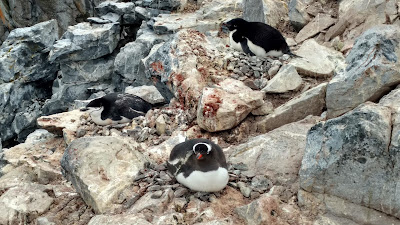
This is a very rare scene, taken at Port Charcot by penguin scientist Steve Forrest. Chinstraps, Gentoos and Adelies are all abundant, but not nesting together! Normally they stick to their own single-species colonies. Steve works with Oceanites, a penguin-counting N.G.O. which has built up an impressive inventory of penguin populations on the Peninsula, as a database to inform future science as the climate changes.
Macaroni Penguins are more a sub-Antarctic species, with only a few nesting pairs in the South Shetland Islands, just north of the Peninsula. Their bright orange plumes seem amost out of place in the monochrome Antarctic landscapes.
Although they are the most abundant penguin in the world (about 9 million pairs), they are not well known as they choose remote, inaccessible sites on scree and in tussock to nest.
It's been all wildlife so far! But I have to include one of the thousands of dramatic ice-scapes that we are lucky enough to admire during a season. This holy ice-berg is in Paradise Harbour. It would have calved from a nearby glacier, and is stuck on the sea-floor. Others float free, and drift around with the wind and currents.
Back to the wildlife! (My work and passion in equal measure). The Antarctic Minke is usually a shy and elusive whale, but this one came close to each of our seven zodiacs in turn, allowing all the passengers who were out on the water an encounter like this. When will the Japanese stop hunting them?
Backtracking in time, I leave the largest whale till last. This Blue Whale surfaced ahead of the ship on our way to South Georgia at the beginning of the season. It is just possible to make out its mottled greyish colour and its small dorsal fin. I was on the bridge when the monumentally tall whale-blow ahead made us all take notice. I was able to announce it on the p.a., and give many passengers a chance to see the largest animal ever to grace the planet.
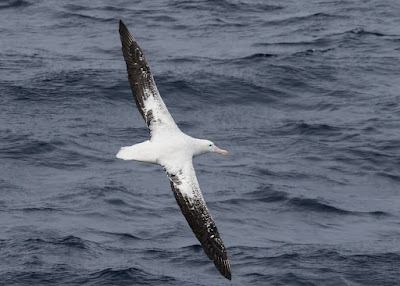
After seven weeks on board, it's time to head north across the Scotia Sea back to Stanley and four flights home. The two sea days are a chance for many to catch up on sleep, but for me they are busy days. There are always seabirds to find, such as six species of albatross and various petrels. This a magnificent old Wandering Albatross, with a wingspan of about 12 ft. Only very mature birds - it may be 30, 40 or 50 years old - lose the white on the tail and show so much white on the leading edge of the wings. Many thanks to various passengers who took most of these images and allowed me to use them. I return to the sister ship, the Akademik Ioffe, for two more voyages in February.
In November I led an Ornitholidays group to Western Ecuador, from Guayaquil southwards to the Peru border. Here I illustrate a few of the local endemics we saw - species confined to Western Ecuador or the Tumbes region: an arid area that south-west Ecuador shares with north-western Peru. Here, at Buenaventura Reserve, the Rufous-headed Chachalaca is a regular visitor to the feeders. The hummingbird feeders here are amazing, attracting over 50 individuals of six or seven species at a time during most hours of daylight.
Next, we visited Jorupe, a small reserve close enough to the Peru border to see its hills across the river below. The feeders here attract many local specialities, such as the White-tailed Jay. Buenaventura, Jorupe and Tapichalaca - three of the lodges we visited - are run by the Jocotoco Foundation, which has ensured the survival of many species by buying reserves in important bird areas.
The Jorupe staff scatter corn below the feeder for species such as the Pale-browed Tinamou. In common with all tinamous, only the male incubates the eggs and protects the young. This species is heard much more than seen in most parts of its range, but at Jorupe one or two have become habituated to regular hand-outs.
The tour proved an Antpitta bonanza, with five species seen and a sixth heard. Here, the normally shy Watkins's Antpitta is persuaded into the open at Jorupe. This is just one species of antpitta that is now venturing out for food. Following the pioneering techniques of Angel Paz, various rare and local antpittas can now be whistled into view with the promise of fresh worms. Angel, once a struggling farmer in the High Andes, is now a well-known conservationist with a thriving eco-lodge on his property.
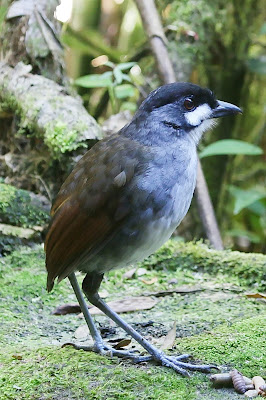
At Tapichalaca in the High Andes, we enjoyed point-blank views of this Jocotoco Antpitta at a feeding station. Angel Paz was brought here to advise on how best to conserve and showcase this rarity, whose total population may be as low as 100 individuals. Named after its call, this bird was the raison d'etre of the foundation that has now taken its name, and runs 11 reserves in various parts of Ecuador. At this reserve and at our next, Copalinga, we had a week of hot, sunny weather. Sounds great, but was anything but ideal for bird activity. These cloud-forests are so called for a good reason, and when the clouds fail to form, many species disappear - either by falling silent and staying out of view, or by migrating elsewhere.
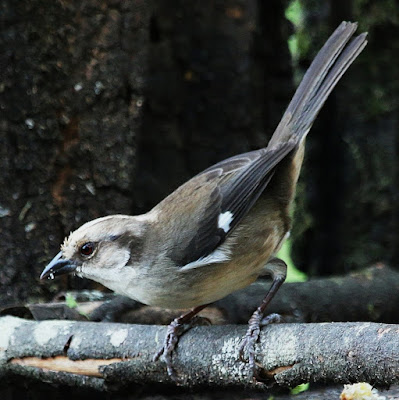
The Pale-headed Brush-Finch has a tiny population too, probably even smaller than Jocotoco's. It is confined to one small reserve in a dry valley near Cuenca. Luckily it was discovered in time to save the scrubby hillside from cultivation. So, The Yunguilla Reserve is another success story of the Jocotoco Foundation. Many more brightly coloured species can be seen here too, but I have gone for the rarity value here!
Finally, here is a male Tit-like Dacnis, a tiny bird in the family of tanagers and honeycreepers. It occurs in Polylepis, a small-leaved shrub that grows near the tree-line in the High Andes. Note that this individual has a ring (band) on its right leg. We found it in the El Cajas National Park, before we returned to Guayaquil for the flight home. Many thanks to Howard Gorringe for allowing me to use his images.
 Chinstraps on their highway up to the ridge above Orne Harbour. (click on image to enlarge)
Chinstraps on their highway up to the ridge above Orne Harbour. (click on image to enlarge)








